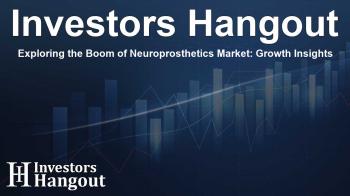Exploring the Boom of Neuroprosthetics Market: Growth Insights

Understanding the Neuroprosthetics Market Landscape
Neuroprosthetics represent a pivotal advancement in medical technology, aiming to improve the quality of life for individuals suffering from neurological disorders. This expanding field is projected to reach an impressive USD 38.93 billion by 2032, growing at a compound annual growth rate (CAGR) of 13.28% from the year 2024 onwards. Such growth is not just a statistic; it signifies a shift in how we approach neurological rehabilitation and treatment.
Current Market Overview
As of 2023, the neuroprosthetics market was valued at USD 12.69 billion, signaling strong demand driven by increasing neurological disorders and the need for sophisticated assistive technologies. Factors such as advancements in brain-computer interfaces (BCIs) and neural stimulation technologies are enhancing the therapeutic possibilities for patients. With populations aging and access to healthcare improving globally, the market is poised for significant expansion.
Market Dynamics and Drivers
Several key factors are propelling the neuroprosthetics market. A significant driver is the rising prevalence of neurological disorders, which necessitate innovative treatment solutions. In addition, the increasing focus on personalized healthcare solutions is pushing manufacturers to invest in advanced technologies that cater to individual patient needs. Robust clinical studies and favorable regulatory frameworks have also catalyzed the adoption of these devices, further supporting market growth.
Segment Analysis: Output vs. Input Neural Prosthetics
In examining the segmentation of the market, output neural prosthetics currently dominate, holding a 55% market share due to their effectiveness in restoring motor functions. Devices such as cochlear implants and motor prosthetics have gained traction, owing to their established benefits and reimbursement structures. However, the input neural prosthetics segment is expected to see the fastest growth, largely fueled by developments in BCIs that can assist with sensory and cognitive disorders.
Regional Insights by Market Performance
Focusing on regional dynamics, North America stands out as the largest market for neuroprosthetics, primarily due to its advanced healthcare infrastructure and a high incidence of neurological conditions. Factors such as substantial research investments and a well-established presence of key market players enhance its dominance. Meanwhile, the Asia-Pacific region is anticipated to emerge as the fastest-growing market due to its rapidly aging population and increased healthcare spending.
Challenges and Opportunities
Despite its growth potential, the neuroprosthetics market faces challenges including high costs associated with advanced devices and variability in reimbursement policies across regions. However, innovation continues to pave the way for opportunities, especially with the increasing integration of artificial intelligence in neurotechnology. As researchers explore new applications and enhance existing solutions, the market is likely to witness exciting developments moving forward.
Key Players in the Neuroprosthetics Market
Understanding the competitive landscape is crucial for stakeholders. Major players in the neuroprosthetics market include renowned companies such as Medtronic plc, Cochlear Ltd., and Boston Scientific, among others. These companies are not just shaping the market with their innovative products but also driving forward research and the development of next-generation devices.
The Future of Neuroprosthetics
As we look ahead, the future of neuroprosthetics appears bright. Continuous advances in technology and a growing understanding of neurophysiology will likely inspire new solutions that cater to unmet medical needs. With public and private investment flowing into this space, the potential for breakthroughs is immense.
Frequently Asked Questions
What is the projected market size for neuroprosthetics?
The neuroprosthetics market is expected to reach USD 38.93 billion by 2032, growing at a CAGR of 13.28% from 2024 to 2032.
Which segment of neuroprosthetics is currently leading the market?
The output neural prosthetics segment holds a 55% share and is currently the leading segment in the neuroprosthetics market.
What are the primary drivers of market growth?
Increasing prevalence of neurological disorders, advancements in assistive technologies, and a growing emphasis on personalized healthcare are key drivers.
How does North America compare to other regions?
North America accounts for the largest share of the neuroprosthetics market due to its advanced healthcare system and high incidence of neurological disorders, while the Asia-Pacific region is anticipated to grow the fastest.
Who are the major players in the neuroprosthetics industry?
Significant players in the neuroprosthetics market include Medtronic plc, Cochlear Ltd., Abbott Laboratories, and Boston Scientific among others.
About The Author
Contact Evelyn Baker privately here. Or send an email with ATTN: Evelyn Baker as the subject to contact@investorshangout.com.
About Investors Hangout
Investors Hangout is a leading online stock forum for financial discussion and learning, offering a wide range of free tools and resources. It draws in traders of all levels, who exchange market knowledge, investigate trading tactics, and keep an eye on industry developments in real time. Featuring financial articles, stock message boards, quotes, charts, company profiles, and live news updates. Through cooperative learning and a wealth of informational resources, it helps users from novices creating their first portfolios to experts honing their techniques. Join Investors Hangout today: https://investorshangout.com/
The content of this article is based on factual, publicly available information and does not represent legal, financial, or investment advice. Investors Hangout does not offer financial advice, and the author is not a licensed financial advisor. Consult a qualified advisor before making any financial or investment decisions based on this article. This article should not be considered advice to purchase, sell, or hold any securities or other investments. If any of the material provided here is inaccurate, please contact us for corrections.

